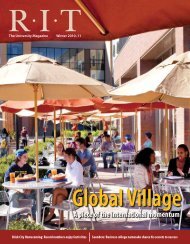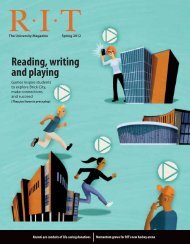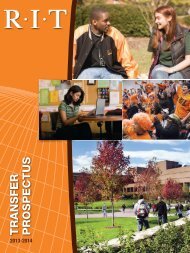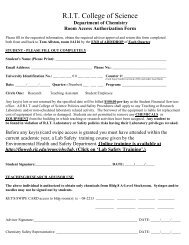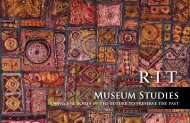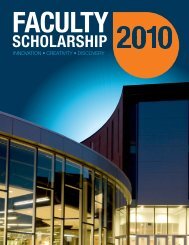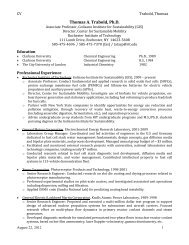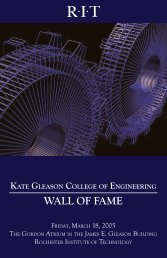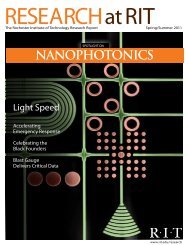Fall / Winter 2012 - Rochester Institute of Technology
Fall / Winter 2012 - Rochester Institute of Technology
Fall / Winter 2012 - Rochester Institute of Technology
Create successful ePaper yourself
Turn your PDF publications into a flip-book with our unique Google optimized e-Paper software.
Related Research<br />
Capstone Projects Making a Difference<br />
Faculty-student teams are<br />
working with local community<br />
agencies to provide novel<br />
assistive devices for individuals<br />
with physical challenges.<br />
The initiative, funded by the<br />
Beth DeBartolo<br />
National Science Foundation,<br />
involves fourth- and fifth-year undergraduate<br />
student design teams in the industrial, electrical,<br />
mechanical, and computer engineering programs<br />
working with partners in the <strong>Rochester</strong> area,<br />
including The Arc <strong>of</strong> Monroe County and Nazareth<br />
College’s School <strong>of</strong> Health and Human Services.<br />
Supervised by a group <strong>of</strong> engineering faculty,<br />
including Elizabeth DeBartolo, associate<br />
pr<strong>of</strong>essor <strong>of</strong> mechanical engineering, the design<br />
teams work hands-on with individuals with<br />
physical challenges in order to design devices<br />
intended to facilitate independent transportation,<br />
prevent injury, and promote rehabilitation.<br />
The projects require students to apply their<br />
engineering and innovation skills throughout<br />
the process <strong>of</strong> creating the device, from the<br />
analysis <strong>of</strong> the needs <strong>of</strong> the consumer to the<br />
construction <strong>of</strong> the prototype.<br />
According to DeBartolo, the senior projects<br />
afford the students an experience that they<br />
cannot get from a technical class.<br />
“The opportunity to see the impact <strong>of</strong> their<br />
engineering decisions shows the students the<br />
The hands-free presentation remote allows signers to manipulate a PowerPoint presentation without<br />
using their hands. Users were given a wireless USB receiver to allow the remote to interface with a<br />
computer and spare batteries.<br />
value <strong>of</strong> their work beyond a financial bottom<br />
line,” she says.<br />
Among the variety <strong>of</strong> projects undertaken,<br />
the team worked with Gary Behm, director <strong>of</strong><br />
the Center on Access <strong>Technology</strong> at NTID, to<br />
design a hands-free wireless presentation<br />
remote. It allows presenters using America Sign<br />
Language to have wireless control <strong>of</strong> a Power-<br />
Point slideshow without the need to carry a<br />
remote in their hands. The device attaches with<br />
a wristband, allowing the presenter to have both<br />
hands free to sign.<br />
“The real value <strong>of</strong> these projects is that<br />
students get to experience the entire design<br />
process and end up with a device that is going<br />
to make a difference in someone’s life,” adds<br />
DeBartolo, whose collaborators include Matthew<br />
Marshall, associate pr<strong>of</strong>essor <strong>of</strong> industrial and<br />
systems engineering, Daniel Phillips, associate<br />
pr<strong>of</strong>essor and director <strong>of</strong> the biomedical<br />
engineering program, and George Slack,<br />
lecturer in electrical engineering.<br />
Improving Assessment <strong>of</strong> Autism<br />
A multi-university research team,<br />
which includes RIT Pr<strong>of</strong>essor<br />
Vincent Pandolfi, is working to<br />
establish evidence-based<br />
assessment protocols for use<br />
Vincent Pandolfi with individuals with autism<br />
spectrum disorders (ASD). The<br />
effort could ultimately enhance the procedures<br />
used by medical doctors, school psychologists,<br />
and clinical psychologists to assess symptoms<br />
and properly diagnose patients.<br />
The research includes one <strong>of</strong> the first series<br />
<strong>of</strong> comprehensive statistical analyses <strong>of</strong> current<br />
ASD and mental health assessment measures.<br />
The research will inform pr<strong>of</strong>essionals about the<br />
measures’ utility for diagnostic decision-making,<br />
treatment planning, and monitoring response to<br />
treatment over time.<br />
“Autism is a neurodevelopmental disorder<br />
characterized by impairments in social<br />
interaction, communication, and behavior<br />
with onset in early childhood,” says Pandolfi,<br />
associate pr<strong>of</strong>essor <strong>of</strong> school psychology at RIT.<br />
“However, specific symptoms can vary widely<br />
between individuals and autism can present<br />
differently within the same person over time,<br />
making diagnosis challenging.”<br />
Research also indicates that individuals with<br />
ASD frequently present with an accompanying<br />
emotional and/or behavioral disorder that<br />
requires specific treatment. Unfortunately,<br />
it is <strong>of</strong>ten hard to accurately identify disorders<br />
like depression and anxiety in autistic patients,<br />
because many <strong>of</strong> these individuals have<br />
difficulty accurately reporting their symptoms<br />
and they may have atypical presentations <strong>of</strong><br />
mental health problems compared with the<br />
general population.<br />
Pandolfi notes that identifying reliable and<br />
valid measures for these patients will help<br />
clinicians more properly diagnose individuals<br />
so treatment can begin as soon as possible.<br />
The research group has also conducted<br />
surveys <strong>of</strong> school-based pr<strong>of</strong>essionals to<br />
assess their levels <strong>of</strong> training and confidence<br />
related to working with students with ASD.<br />
The results will inform the field about training<br />
needs <strong>of</strong> school psychologists and other<br />
school pr<strong>of</strong>essionals and will help identify<br />
future directions for research.<br />
“The earlier we can detect ASD and<br />
Enhancing Understanding <strong>of</strong> Autism: School<br />
psychology pr<strong>of</strong>essor Vince Pandolfi is working<br />
to improve testing and assessment <strong>of</strong> autism<br />
and the corresponding mental disorders that<br />
<strong>of</strong>ten accompany the disease.<br />
co-occurring emotional and behavioral<br />
disorders, the earlier we can provide specific<br />
treatment and hopefully improve the quality <strong>of</strong><br />
life <strong>of</strong> affected individuals and their families,”<br />
adds Pandolfi.<br />
The research team also includes Dr. Caroline<br />
Magyar, associate pr<strong>of</strong>essor <strong>of</strong> pediatrics at<br />
the University <strong>of</strong> <strong>Rochester</strong> Medical Center,<br />
and Charles Dill, pr<strong>of</strong>essor <strong>of</strong> psychology at<br />
H<strong>of</strong>stra University.<br />
Research at RIT<br />
13



